Tracked troop carrier LTV
The multipurpose transporter, which gave life to the entire family of these combat vehicles, was created by D. Roebling in 1935-1937. In 1938-1941, by the order of the US Navy, Robbling developed a military version of this conveyor, which was produced in various versions in 1941-1945. Over the years of the Second World War, more than 18,5 thousand of these tracked amphibious assault vehicles were released. So, from 1941 to 1945. US businesses have launched 15 498 unarmored floating transporters, from 1943 to 1945 year - 450 armored transporters, 509 amphibious tanks and 2159 fire support vehicles.
Tracked amphibious assault vehicles LTV and other military equipment based on them were widely used by the US Army and Marine Corps from 1942 in the battles of World War II. First of all, this technique was used in the Pacific in battles with the Japanese. On a much smaller scale, these amphibians were used in Europe, for example, during the Italian campaign, as well as battles in Western Europe, but not during Operation Overlord, but only to overcome inland water barriers (when crossing the Rhine). LTV also managed to take part in the Korean War, but by the middle of the 1950-s had been completely decommissioned. They were replaced by floating amphibious armored personnel carriers of the new generation LVT-5. At the same time, LVT cars in significant quantities were exported to the Allied Americans of the country, in some they served up to the 1970-s.
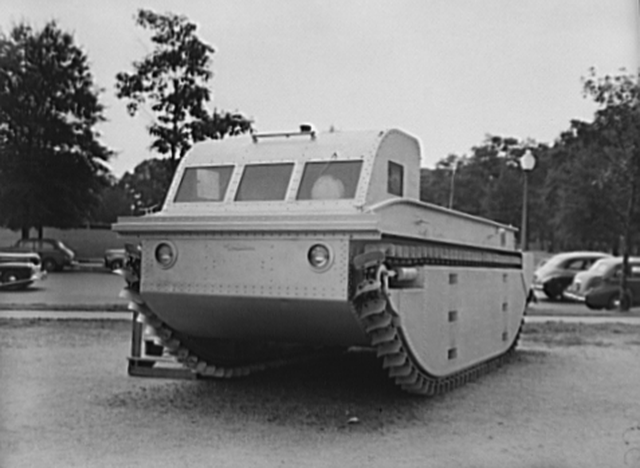
Tracked Amphibious Vehicle LTV
The development process of LVT amphibious tracked vehicles seriously accelerated the events of World War II. At the same time, amphibious tanks, created on the basis of conveyors, were similar in design to the undercarriage, hull, buoyancy, components and assemblies used to floating conveyors. The difference was only in the availability of armor and artillery weapons (cannon or howitzer) mounted in the turret, as well as the layout of the main components and assemblies. For example, if in floating transporters, due to the presence of a folding stern, the power plant was located in the front, then on all lightweight amphibious tanks the engines were in the stern.
The hulls of amphibious transporters were designed in such a way as to facilitate their movement by water as much as possible. At the same time, of all the floating conveyors, only LVT (A) 2 had a reservation. Cases of all other conveyors were made of ordinary steel unarmoured sheets. Floating conveyors could not have any weapons or were armed with several machine guns. Their capacity, including the three crew members, reached 24-27 people. The carrying capacity of tracked amphibious assault vehicles ranged from 11 to 16,5 tons. The ground pressure was at the level of 0,5-0,6 kg / cm.
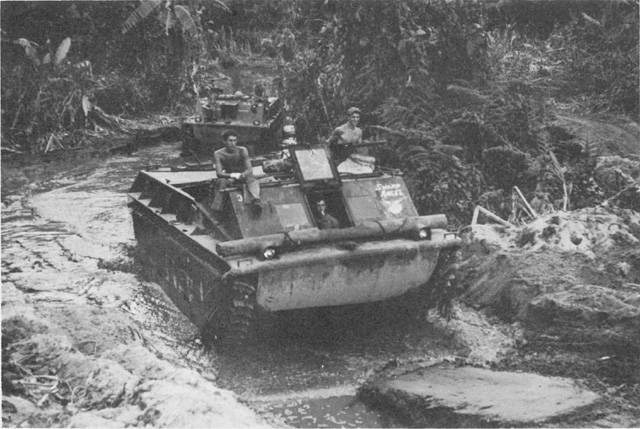
Powertrain amphibious transporters consisted of the main clutch, 5-speed gearbox, double differential, which was used as a steering mechanism, as well as final gears. The main feature of the American transporters and light amphibious tanks was the absence of rudders and the propeller. The movement of amphibians both on the water surface and on land was carried out with the help of caterpillars, whose tracks, having a width of 360 mm, were equipped with sharply protruding removable blades. The driver could turn the car using braking or stopping one of the tracks.
The first LVT transporters (1) were armed with two 7,62-mm machine guns. But even before the battle for Tarawa, a number of transporters were equipped with two large-caliber 12,7-mm machine guns and, in addition, 7,62-mm machine guns at the stern. They did not have reservations, and their thin body practically did not play any protective role. Conveyors showed good throughput when driving on sandy surfaces, but had certain problems in overcoming hard-surface areas. The correct operation of the first conveyors was often problematic, and the cars of the first releases suffered from fairly frequent breakdowns. Crews and paratroopers almost tested the machine directly in combat conditions.
For the most part, LVT (3) transporters were not armored and differed from the LVT (2) transporter mainly with a new power plant, which consisted of two Cadillac automobile engines, which had somewhat lower power (220 hp) and were in communication with the appearance of a folding ramp in front of the landing vehicle. The armament of the LVT transporters (3) consisted of two 7,62-mm machine guns, the weight was 11 tons, carrying capacity - 3,6 tons, the maximum speed on land was 37 km / h, and on the water - 12 km / h. In 1949, all LVT transporters (3) were equipped with a roof, receiving a new designation LVT (3) c.
LVT (A) 1 and LVT (A) 4 Tanks
The aft hatches on the tank were intended for embarkation and disembarkation of the crew and landing force, as well as for loading various cargoes. The layout of components and assemblies in the floating tank remained the same as on the LVT2 conveyor, that is, the engine was located in the stern. Due to the short period of design work and the excellent organization of production, Borg Warner was able to quickly produce 509 amphibious LVT (A) 1 tanks in a short time. The mass of the combat vehicle was 15 tons, the crew - 6 people. The 250-strong engine provided the 32 km / h on land and 12 km / h on the water to a lightweight floating tank.
The layout of the main units of the power plant and transmission in a light floating tank LVT (A) 4 differed from the layout on the landing conveyor LVT (4), namely: the engine compartment was in the back, it was located the same engine as the LVT (4) who developed power 250 l. with. Light tank received a radio station. A total of about 1890 light tanks of LVT (A) 4 amphibious tanks were released. The following modification of this combat vehicle - LVT (A) 5 differed only in the presence of an electric drive of the rotation of the turret and stabilized by a howitzer. This version of the light tank was released in a series of 269 units.
An attempt to strengthen the armament of a light amphibious tank LVT (A) 4 led to the development of a modification of the combat vehicle with a turret from the M24 tank. In January, 1945, the first prototype was ready, which differed from its predecessor and the new hull superstructure. The improved tank proved to be quite confident in the tests, but due to the end of the Second World War it did not set out for mass production.
In the 1944-1945, a number of amphibious tracked vehicles were used by the Allies in Europe, in particular, they were used in Germany when crossing the Rhine River in March of the 1945 of the year. Organizationally, these combat vehicles were consolidated into battalions of floating armored personnel carriers and tanks. After the end of the Second World War in the United States, work continued on the creation of new tracked amphibious vehicles for the Marine Corps units.
Along with this, in the armament of some companies and battalions of floating transporters of armored troops, as well as in the USCM, LVT transporters (4) and LVT / A (4) and LVT (5) amphibious tanks continued to remain as limited standard combat vehicles. They managed to take part in the hostilities in Korea, in particular during the landing of the amphibious assault forces in September 1950. In addition, they were used when crossing the river. A large number of tracked floating transporters were later dismissed from the US Army and transferred to the armies of the allied capitalist states, including France and the United Kingdom.
Information sources:
http://pro-tank.ru/bronetehnika-usa/plavaush-tanki/160-plav-lvt
http://all-tanks.ru/content/gusenichnaya-desantnaya-mashina-lvt
http://www.telenir.net/transport_i_aviacija/bronetankovaja_tehnika_armii_kapitalisticheskih_gosudarstv/p17.php
http://litresp.ru/chitat/ru/Н/nersesyan-mihail-grigorjevich/bronetankovaya-tehnika-armij-kapitalisticheskih-gosudarstv/17
Open source materials
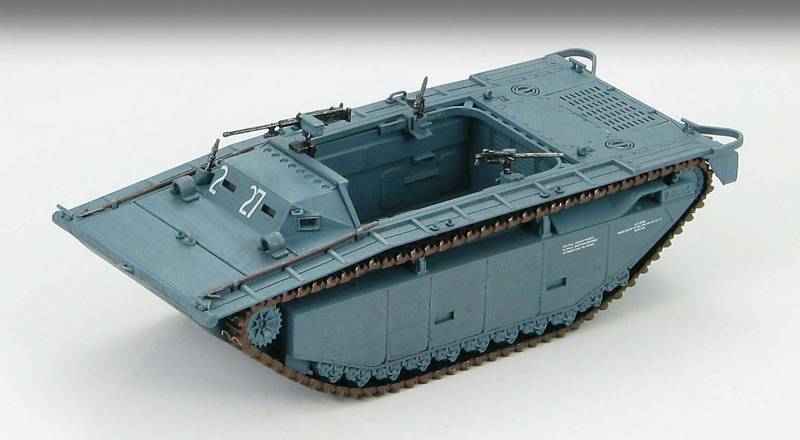
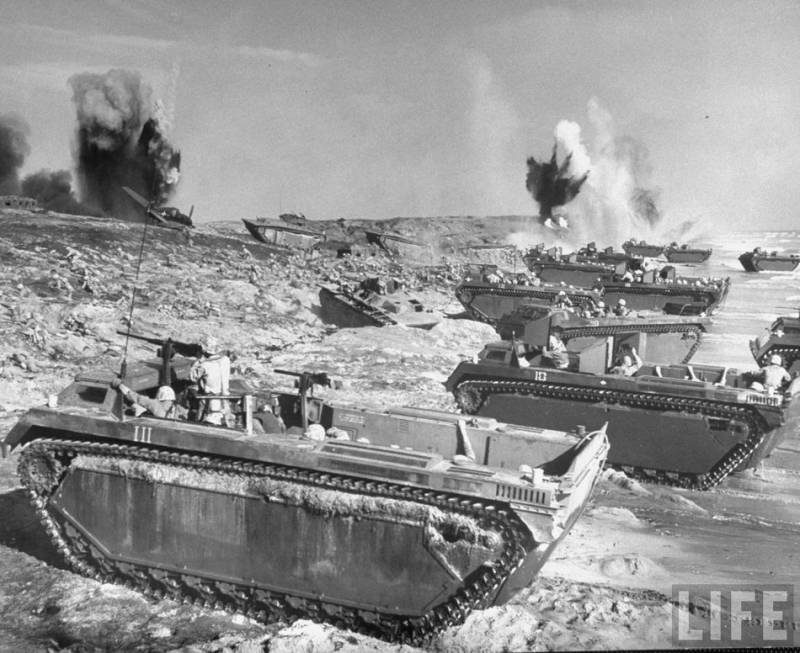
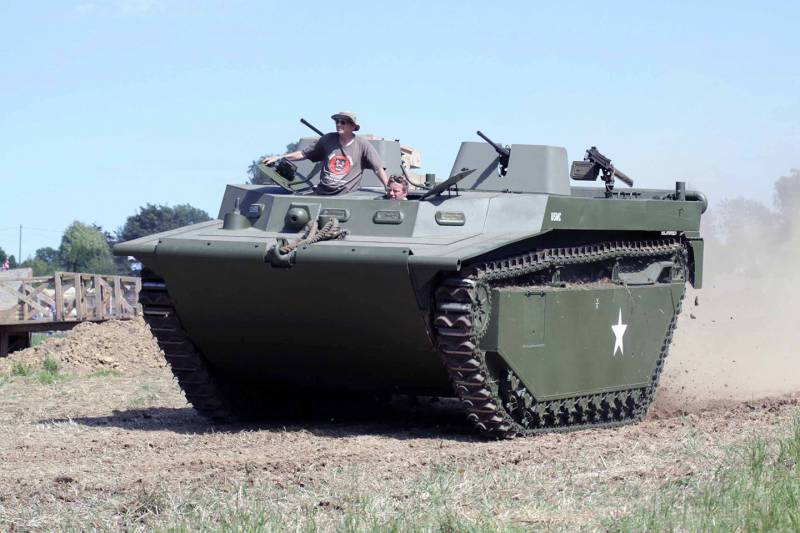
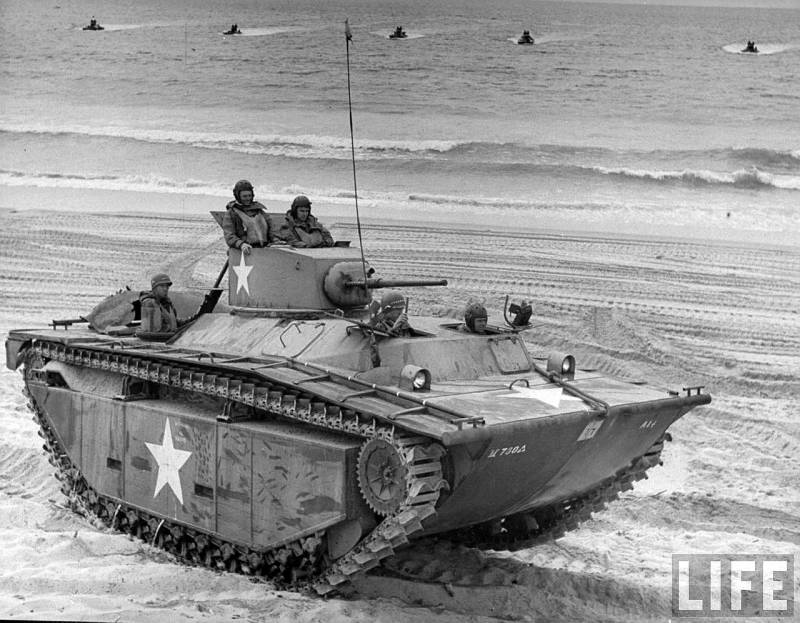
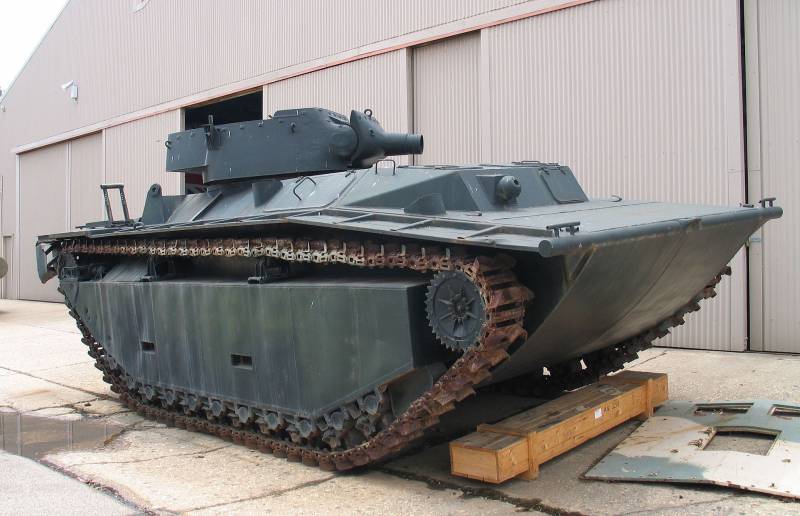
Information